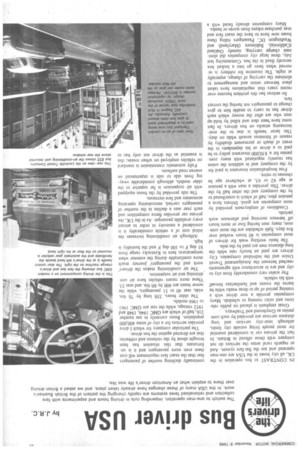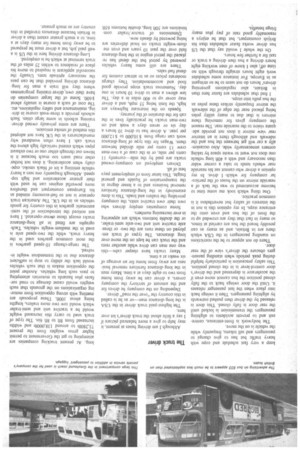Bus driver USA by J . R . C.
Page 97

Page 98

If you've noticed an error in this article please click here to report it so we can fix it.
The switch to one-man operation, impending cuts in driving hours and experiments with fare collection and rationalized fares systems are rapidly changing the pattern of the British Busman's work. In the USA many of these changes have already taken place, and we asked a Briton driving over there to explain 'what an American driver's life was like.
IN 'CONTRAST to bus operation in the UK, all city buses in the USA are one-man operated and use the flat-fare system. And as regards rural areas the services do not compare with those offered in Britain. In fact the private car is considered essential for most people living outside city limits, although inter-city services and longdistance services are provided by such companies as Greyhound and Trailways. , Great emphasis is placed on public relations and strict running to schedule. Many companies provide a new driver with a training period of up to three weeks while he learns the routes and familiarizes himself with his vehicle.
Pay scales vary considerably from city to city and are in accordance with agreements. reached between the Amalgamated Transit Union and the individual companies. City drivers are paid an hourly rate while the long-distance men are paid by the mile.
The basic working week for drivers of most companies is 40 hours worked over five days. Split schedules are the most common, many men having four or more hours off between morning and afternoon work 'periods.
Conditions of employment provided by most companies are good. Drivers have a pension plan, half of which is contributed to by the company and the other half by the driver. This provides a man with a pension at age 62 or 65, at whichever age he chooses to retire.
Free hospitalization insurance is paid for by the company and in addition the union has recently negotiated with many companies for a $50,000 insurance policy to be paid to a driver or his dependants in the event of death or permanent disability by reason of felonious assault while on duty. This latter benefit is due to the everincreasing attacks on bus drivers. In fact some have 'been shot and killed by hold-up men who are after the money which each driver has to carry to enable him to give change to passengers not having the correct fare.
So serious has this problem become over recent years that negotiations have taken place between union and management to eliminate the carrying of change, especially at night. The incentive for robbery is removed when fares go into a locked box securely fixed in the bus. Commencing last July, three large city companies did eliminate change carrying, namely Oakland (California), Baltimore (Maryland) and Washington DC. Passengers riding these buses now have to have the exact fare and may purchase tokens from stores or banks. Many companies already faced with a continually declining number of passengers fear that the exact fare requirement will cost them even more passengers and it is unfortunate that this situation has been brought about by the violence and robberies that are directed against the bus driver.
The particular company for which I drive provides services for a city of some 400,000 population. Buses currently in use number 216, half of which are GMC 1946, 1948 and 1952 vintage, while the rest are GMC 1961 to 1966 models.
The older buses, 35ft long by 7ft 6in. wide, seat 40 to 51 passengers, while the newer buses are 40ft by 8ft 6in. and seat 51 These more recent vehicles have air conditioning and air suspension.
The air conditioning makes the drivers' work and the passengers' journey much more comfortable during the summer when temperatures here in Kentucky range from 85 deg F to 100 deg F and the humidity is high.
Although air conditioning increases the initial cost of a vehicle considerably it is considered a necessity in order to attract every available passenger. As in the UK, the private car provides fierce competition and each year sees a decline in the number of passengers carried, necessitating operating economies and fare increases.
The ride provided by the buses equipped with air suspension is far superior to the older models, although considerable swaying from side to side is experienced on uneven road surfaces.
Fully automatic transmission is standard on vehicles employed on urban routes; this is essential as the driver not only has to keep a very fast schedule and cope with heavy traffic but has to give change to passengers and sell tokens, frequently while the vehicle is on the move.
The bodywork is front-entrance, centreexit and to prevent accidents to alighting passengers the transmission is locked until the rear door is fully closed. This door is released by the driver then pushed outwards by alighting passengers. Then it swings back into place when the last passenger releases it. .Until the door swings back to the fully closed position the .bus cannot move even if the accelerator is depressed and the driver's door control-lever is in the closed position. This safety precaution is particularly helpful during peak periods when standing passengers obscure the driver's view of the rear door.
There do not appear to be the restrictions on standing passengers in the USA which there are in Britain, and as many as can possibly board the bus are carried at times, so many in fact that they are crowded up to the front of the bus and even onto the entrance steps. In my opinion this is not in the interests of safety but nevertheless it is common practice.
. One thing which took me some time to become accustomed to was the lack of a nearside mirror on the buses of the particular company for which. I drive. In my opinion a driver who cannot see his nearside rear wheels tends to take a corner wider than necessary and with a 40ft long vehicle one does not want to waste space by taking corners unnecessarily wide. Also occasionally a car will get between the bus and the sidewalk and although there is an interior rear view mirror it does not provide adequate vision to the nearside rear. The reason the company gives for removing these mirrors is that due to many utility poles being placed near the edge of the sidewalk the mirror frequently strikes these poles as the bus pulls into stops.
• I find that schedules are faster here than in Britain, also regulations governing drivers' hours do not seem to be so stringent as in Europe. For instance some schedules work eight hours straight through with no time off; also I know of men working eight hours driving a bus then driving a truck or taxi for a further few hours.
On the whole I would say that the US bus driver works faster schedules than his British counterpart, but that he enjoys a reasonably good rate of pay plus many fringe benefits. The truck driver Although am driving buses at present, it may help to give a more balanced picture if I say a little about the truck driver's lot over here.
The highest-paid truck driver in the USA is the long-distance man—or as he is called in this country the "over the road" driver.
Depending on the company he drives for and the amount of territory the company covers, a driver can be away from home from two to eight days at a time. Many men in the long -distance furniture removal business are away from home for an average of six weeks at a time.
Many trucks have sleeper cabs—this way one man can drive while another rests and the truck can be kept on the move over long distances. The types of truck employed on these runs are the twoor threeaxle tractive unit and two-axle semi-trailer, or the double bottoms which are appearing in ever-increasing numbers.
Some companies employ drivers who own their own tractive units, the company providing the trailers and loads. This is done extensively in the long-distance furniture removal business and to a lesser degree in the transportation of liquids and general freight. This latter form of employment pays best of all.
Drivers employed on company-owned trucks are paid by the mile—currently 11 cents per mile, or in the case of a two-man crew 13 cents per mile divided between them. Wages for this type of long-distance work can range from S 10,000 to $12,000 per year. A driver has to drive 10 hours a day six or seven days a week and on two-man trucks he practically lives in the cab for the duration of the journey.
Speeds on the interstate highways are high, the limit being 55 mph, and a driver may cover up to 400 miles in a day. The law allows a man to drive 10 hours in one day. Numerous truck stops provide good food and accommodation. They charge moderate prices so as to attract custom for diesel fuel sales.
There are still some heavy vehicles powered by petrol but the diesel has replaced the petrol engine in the long-distance field over the past 10 years and even medium-weight trucks on local deliveries are being powered by diesels now.
Dimensions of tractor /trailer combinations are 50ft long, double bottoms 65ft
long. At present trucking companies are attempting to get the Government to permit higher gross weights from the present 73,280Ib to around 138,000lb and widths increased from 8ft to 8ft 6in. The type of truck used to carry this increased weight would be a tractive unit and semi-trailer which would tow two more trailers, lengths being about 100ft. These proposals are meeting with strong opposition from motoring organizations on the grounds that such weights would cause damage to road surfaces plus hazards to motorists attempting to pass such long vehicles. Another point the opposition makes is that such vehicles would lack the ability to stop in sufficient distance due to the tremendous weight involved.
The range-change 10-speed gearbox is the most common gearbox used in the heavy truck, while the two-speed axle is used in the medium-weight vehicles. Tachographs are fitted in all long-distance trucks except those Avner-operated. I have not noticed the introduction of the semiautomatic gearbox in this country for goods vehicles as in the UK. The American truck operator is not so fuel-economy minded as his European counterpart and therefore more powerful engines can be used with their greater acceleration and high topspeed. Although frequently one sees a heavy vehicle emitting a lot of black smoke, especially when accelerating, it does not bother other road users too much because it is blown out through either one or two exhaust pipes which extend vertically high above the truck cab. I have often wondered why manufacturers in the UK have not adopted this method of smoke emission.
There are some privately owned drivertraining schools in some large cities. Such schools provide a three-week course in driving, maintenance and safety regulations, etc. The cost of such a course is usually about $600. Some of the larger companies do have their own driver-training programmes where they will train a man for longdistance driving provided that he can pass the necessary aptitude tests. Usually the successful applicant is required to move his place of residence to within 25 miles of the truck terminal at which he is employed.
Long-distance driving here in the US is a well paid job, but a driver must be prepared to be away from home for many days at a time, to a much greater extent than a driver in Britain because distances travelled in this country are so much greater.




























































































































































